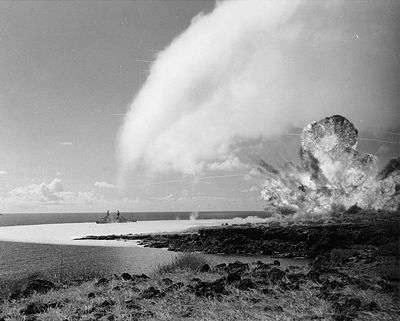Operation Sailor Hat

Operation Sailor Hat was a series of three tests of explosives effects, conducted by the United States Navy on the island of Kahoʻolawe, Hawaii in 1965.[1] They were non–nuclear tests employing large quantities of conventional explosives (i.e. TNT) to simulate the effects of a nuclear weapon blast, such as the effects upon naval vessels. In addition, seismological data, underwater acoustics, radio communications, cratering, air blast effects, cloud growth, fireball generation, and electromagnetic data were gathered. The light cruiser USS Atlanta, the guided-missile destroyer leaders USS England and USS Dale, the guided-missile destroyers USS Cochrane, USS Benjamin Stoddert, and USS Towers, and the Royal Canadian Navy's escort destroyer HMCS Fraser all participated in the trial.
Each "Sailor Hat" test consisted of a dome-stacked 500-ton (450 t) charge of TNT high explosive detonated on the shore of Kahoʻolawe close to the ships under test. Each test saw the USS Atlanta move closer to the explosion. The first test, called Bravo, occurred on 6 February 1965, with the second test, called Charlie, on 16 April and the last, codenamed Delta, on 19 June.
Effects
Cameras recorded the blast effects inside the ships and have shown that the force of the blast was enough to buckle steel walls and tear off heavy radar equipment and send it flying.[2] Although severely damaged, the ships stayed afloat. In addition, two observation blimps were destroyed high above ground by the shock wave. USS England, which was farthest from the blast center, experienced the least damage, the most serious of which was only a dent where a boulder had hit the ship.
The crater left by the blast is called the "Sailor's Hat" crater and holds an anchialine pool containing Halocaridina rubra shrimp, which have adapted to the conditions in the crater.[3]
 The blast; the shockwave is visible on the water, and a condensation cloud is visible above the fireball. The USS Atlanta is in the background.
The blast; the shockwave is visible on the water, and a condensation cloud is visible above the fireball. The USS Atlanta is in the background.- The crater created by Operation Sailor Hat
References
- ↑ "USS England official website". Cg22.ussengland.org. Retrieved 2013-07-01.
- ↑ Operation Sailorhat 1965. Retrieved 2014-12-16.
- ↑ Brock, R.; J. Bailey-Brock (1997). "An Unique Anchialine Pool in the Hawaiian Islands". International Review of Hydrobiology. 83 (1): 65–75. Retrieved 2010-04-01.
External links
| Wikimedia Commons has media related to Operation Sailor Hat. |
- "Photos of the Sailor Hat test in 1965". US Navy. Archived from the original on July 22, 2012.
- YouTube video of Operation Sailor Hat
Coordinates: 20°30′15″N 156°40′44″W / 20.50417°N 156.67889°W